外国人对中国古代诗歌教学策略的认知研究英文版.
外国人 学习古诗词 英语作文
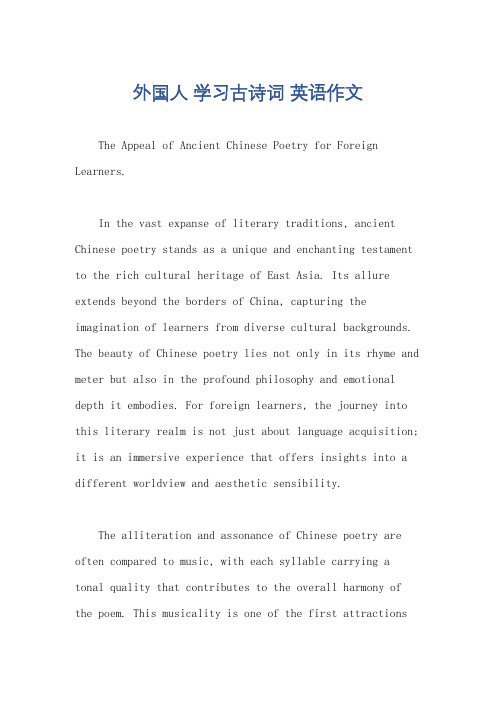
外国人学习古诗词英语作文The Appeal of Ancient Chinese Poetry for Foreign Learners.In the vast expanse of literary traditions, ancient Chinese poetry stands as a unique and enchanting testament to the rich cultural heritage of East Asia. Its allure extends beyond the borders of China, capturing the imagination of learners from diverse cultural backgrounds. The beauty of Chinese poetry lies not only in its rhyme and meter but also in the profound philosophy and emotional depth it embodies. For foreign learners, the journey into this literary realm is not just about language acquisition; it is an immersive experience that offers insights into a different worldview and aesthetic sensibility.The alliteration and assonance of Chinese poetry are often compared to music, with each syllable carrying atonal quality that contributes to the overall harmony of the poem. This musicality is one of the first attractionsfor foreign learners. The challenge, however, lies in mastering the intricate system of tones and characters that underlie these poetic melodies. Despite the difficulties, the reward is immense as learners begin to appreciate the beauty of Chinese language in its literary form.Beyond the linguistic challenges, ancient Chinese poetry presents a window into the cultural and historical context of the ancient Chinese civilization. Poems like the "Book of Songs" or the works of Du Fu and Li Bai reflect the social, political, and emotional life of their times. For foreign learners, understanding these poems is not just about learning vocabulary or grammar; it is about connecting with a different historical era and cultural mindset.The philosophical underpinnings of Chinese poetry also hold a special appeal for foreign learners. The concepts of harmony with nature, the transience of life, and thepursuit of spiritual enlightenment are themes that resonate across cultures. By studying Chinese poetry, learners gain insights into these universal themes from a unique Easternperspective, enriching their understanding of human experience and wisdom.Moreover, the emotional depth of Chinese poetry often strikes a chord with foreign learners. The poems' expressions of love, loss, joy, and sorrow resonate across cultural barriers, connecting people on an emotional level. The honest and raw emotions expressed in these poems offer a powerful connection between the learner and the ancient Chinese writers, bridging the gap between time and space.In conclusion, the appeal of ancient Chinese poetry for foreign learners lies in its musicality, cultural depth, philosophical wisdom, and emotional resonance. The journey into this literary world is not just a linguistic exercise; it is a transformative experience that broadens thelearner's cultural horizons and enriches their understanding of human expression and wisdom. As they delve into the rhymes and meters of ancient Chinese poetry, foreign learners discover a shared humanity that transcends linguistic and cultural boundaries.。
教外国人学唐诗的英语作文

教外国人学唐诗的英语作文Studying Tang poetry is a great way for foreigners to understand Chinese culture and language. Tang poetry is not only beautiful and profound in its language, but it also reflects the thoughts and emotions of the Chinese people during that time period.First of all, studying Tang poetry can help foreigners improve their Chinese language skills. By learning the ancient language and grammar used in Tang poetry, foreigners can gain a deeper understanding of the Chinese language and its history. This can be especially helpfulfor those who are learning Chinese as a second language.Secondly, Tang poetry provides a window into the culture and history of ancient China. Many Tang poems depict the landscapes, customs, and social issues of that time period, allowing foreigners to gain insights into the traditions and values of Chinese society. By studying Tang poetry, foreigners can develop a greater appreciation for Chinese culture and its rich literary heritage.Furthermore, Tang poetry can also inspire foreigners to explore the beauty of Chinese traditional aesthetics. The elegant and vivid imagery in Tang poems often evokes a sense of harmony with nature and the universe, which can be a source of inspiration for people from all walks of life. By delving into the world of Tang poetry, foreigners can broaden their artistic horizons and gain a deeper appreciation for the beauty of Chinese art.In conclusion, studying Tang poetry can be a rewarding experience for foreigners who are interested in Chinese language, culture, and art. Through the study of Tang poetry, foreigners can not only improve their language skills, but also gain a deeper understanding of Chinese history and culture, and find inspiration in the beauty of Chinese traditional aesthetics.学习唐诗是外国人了解中国文化和语言的好方法。
教外国人学唐诗的英语作文五十个字

教外国人学唐诗的英语作文五十个字English:Teaching foreigners Tang poems can be a rewarding experience as it allows them to not only appreciate the beauty of Chinese literature, but also gain insight into the history, culture, and the lives of people in ancient China. It is important to provide them with background knowledge about the poet, the historical context of the poem, and the meanings behind the metaphors and symbolism used. Additionally, it is beneficial to use various teaching methods such as recitation, translation, and discussion to help them understand and appreciate the poems. By doing so, foreigners can develop a deeper understanding and connection to Chinese culture and history.中文翻译:教外国人学唐诗可以成为一种有意义的体验,因为这不仅让他们欣赏中国文学的美,还可以让他们了解古代中国的历史、文化和人们的生活。
重要的是要为他们提供有关诗人、诗歌的历史背景以及隐喻和象征意义的知识。
此外,使用各种教学方法,如背诵、翻译和讨论,有助于帮助他们理解和欣赏诗歌。
外国人对中国古代诗歌教学策略的认知研究 英文版
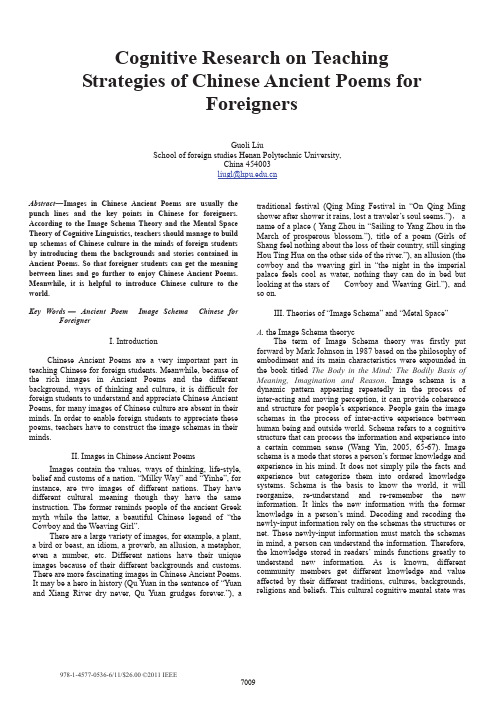
Cognitive Research on Teaching Strategies of Chinese Ancient Poems forForeignersGuoli LiuSchool of foreign studies Henan Polytechnic University,China 454003liugl@AbstractüImages in Chinese Ancient Poems are usually the punch lines and the key points in Chinese for foreigners. According to the Image Schema Theory and the Mental Space Theory of Cognitive Linguistics, teachers should manage to build up schemas of Chinese culture in the minds of foreign students by introducing them the backgrounds and stories contained in Ancient Poems. So that foreigner students can get the meaning between lines and go further to enjoy Chinese Ancient Poems. Meanwhile, it is helpful to introduce Chinese culture to the world.Key Wordsü Ancient Poem Image Schema Chinese forForeignerI. IntroductionChinese Ancient Poems are a very important part inteaching Chinese for foreign students. Meanwhile, because ofthe rich images in Ancient Poems and the differentbackground, ways of thinking and culture, it is difficult forforeign students to understand and appreciate Chinese Ancient Poems, for many images of Chinese culture are absent in theirminds. In order to enable foreign students to appreciate thesepoems, teachers have to construct the image schemas in theirminds.II. Images in Chinese Ancient PoemsImages contain the values, ways of thinking, life-style,belief and customs of a nation. “Milky Way” and “Yinhe”, forinstance, are two images of different nations. They have different cultural meaning though they have the sameinstruction. The former reminds people of the ancient Greekmyth while the latter, a beautiful Chinese legend of “theCowboy and the Weaving Girl”.There are a large variety of images, for example, a plant,a bird or beast, an idiom, a proverb, an allusion, a metaphor, even a number, etc. Different nations have their uniqueimages because of their different backgrounds and customs. There are more fascinating images in Chinese Ancient Poems.It may be a hero in history (Qu Yuan in the sentence of “Yuan and Xiang River dry never, Qu Yuan grudges forever.”), a traditional festival (Qing Ming Festival in “On Qing Ming shower after shower it rains, lost a traveler’s soul seems.”)ˈ a name of a place ( Yang Zhou in “Sailing to Yang Zhou in the March of prosperous blossom.”), title of a poem (Girls of Shang feel nothing about the loss of their country, still singing Hou Ting Hua on the other side of the river.”), an allusion (the cowboy and the weaving girl in “the night in the imperial palace feels cool as water, nothing they can do in bed but looking at the stars of Cowboy and Weaving Girl.”), and so on.III. Theories of “Image Schema” and “Metal Space”A. the Image Schema theorycThe term of Image Schema theory was firstly put forward by Mark Johnson in 1987 based on the philosophy of embodiment and its main characteristics were expounded in the book titled The Body in the Mind: The Bodily Basis of Meaning, Imagination and Reason. Image schema is a dynamic pattern appearing repeatedly in the process of inter-acting and moving perception, it can provide coherence and structure for people’s experience. People gain the image schemas in the process of inter-active experience between human being and outside world. Schema refers to a cognitive structure that can process the information and experience into a certain commen sense (Wang Yin, 2005, 65-67). Image schema is a mode that stores a person’s former knowledge and experience in his mind. It does not simply pile the facts and experience but categorize them into ordered knowledge systems. Schema is the basis to know the world, it will reorganize, re-understand and re-remember the new information. It links the new information with the former knowledge in a person’s mind. Decoding and recoding the newly-input information rely on the schemas the structures or net. These newly-input information must match the schemas in mind, a person can understand the information. Therefore, the knowledge stored in readers’ minds functions greatly to understand new information. As is known, different community members get different knowledge and value affected by their different traditions, cultures, backgrounds, religions and beliefs. This cultural cognitive mental state wasstored in mind in the pattern of schemas and it forms the cultural cognitive schema.B. Metal Space TheoryG. Fauconnier put forward Metal Space Theory in his book Metal Space(1985/1994). He raised Conceptual Integration Theory(1997) and Conceptual Blending Theory(2002) in recent years. According this theory, the metal space is divided into four parts of input space I, input space II, blending space and generic space. The four spaces are linked with mapping to form a conceptual blending net. The process of mapping from input space to blending space is called “compression”, that is, it is a process to simplify the complex concepts from different input spaces to a new, complete and united space. The blending concepts are stable and easy to remember. Of its function, mental space is way we unconsciously organize our background cognitive process when we speak and think. By mapping and inserting the partial structure and background, new structure, action, concept, feeling and understanding will be formed in the blending space.IV. Strategies of image teaching in ancient poemsWestern poems stress on logical reasoning and are very rigorous; while the Chinese poems stress on image combination, very vagarious and indirect. It is just the vague and indirect words that fly the reader’s imagination, so that reader s can feel the boundlessness and magnificence of the sentences “straightly rising the military smoke in the sands, more round seems the sinking sun over the broad river.” Chinese readers have the same background and culture so that they can get the similar feeling. The images of “the sands”, “military smoke”, “broad river” and “sinking sun” can trigger them the similar imagination. While the foreign students cannot gain the same feeling because of the different background, they cannot appreciate the beauty of Chinese ancient poems.A. Construction of Image SchemaThere will be two input spaces in foreign students’ minds according to the Metal Space Theory: one is the cognitive domain of Chinese culture and the other is the domain of native culture. The two spaces will interact and connect and finally form a new blending space. While reading Chinese poems, foreign students will understand them with their native culture and way of thinking unconsciously and of cause, they will get different understanding. The reason is the absence of Chinese images in their minds. So we have to try to contrast the Chinese images in the foreign students’ minds, because, according to G. Fauconneir, these images schemas will be stored for a long time in their minds. When they get to know the story of “the cowboy and the weaving girl”, for example, they will not equal “the Silver River” in Chinese culture with “ the Milk Way” in the western culture.B. Strategies to construct image schemaIn teaching Chinese for foreigners, teachers usually explain the meanings of the poems to students only, instead of analyzing the culturing meaning of the images for the reason that teachers may also be lack of the knowledge of ancient poems. So the foreign students cannot enjoy the beauty of the poems though they get the meaning. Vagueness is one character of Chinese ancient poems, it enables readers to imagine freely. Otherwise, Chinese ancient poems contain rich meanings with less words. That is because in Chinese ancient poems there are a great number of images, Chinese readers can produce rich imagination while reading them, they can get the true meaning that the images contain and further more, they can enjoy the poems. But this is not true for foreign students for they don’t have these image schemas in their minds, they don’t know the cultural background and the meaning they contain. If teachers fail to explain the images to foreign students, it will cause the loss of culture and they cannot get the true meaning of the poems. So, in the process of teaching, teachers must show both the cultural background and true meaning of the images to foreign students. So that the foreign students can construct the image schemas of Chinese culture in their minds and they will not misunderstand them when in read them in other poems.Li Bai’s Qing Ping Tune (the Second), for example:A red red peony passes its fragrance to the pearls of dew,Even the Clouds and Rain of Mount Wu are not as fair as you.Who is, in the palace of Han, alike?Feiyan has to turn to her dress new.This is the second one of the three poems in the title of Qing Ping Tune written by Li Bai to eulogize Yang Guifei. Li Bai combines the peony and Yang Guifei together, peony is Yang Guifei and Yang Guifei is as pretty as peony. The first line describes the bright color and tempting aroma of the peony, even the dews on it are fragrant. So beautiful is the peony and so pretty is Yang Guifei. They are more fairy than the Goddess of Mount. Wu who is flowing cloud in the morning and light rain in the evening. Even Zhao Feiyan, the beauty of Han Dynasty, has to turn to new dresses.In this poem, the poet quotes the allusions of “Clouds and Rain of Mount. Wu” and “Zhao Feiyan”. But the foreign students have no the image schemas of the two stories. They know nothing about the Goddess of Mount. Wu and Zhao Feiyan if teachers do not tell them the stories and they would not grasp the beauty of the poem. So teachers must tell the stories to foreign students.According to the record of Gao Tang Fu written by Song Yu, once Chu Xiangwang (the King of Chu Kingdom) traveled to a Cloud–and-Dream Platform together with Song Yu. Seen from far away, the platform was surrounded by changeable clouds. Chu Huaiwang asked Song Yu: “what’s the air?” Song Yu answered: “it is the so-called Clouds. Once a time, our former king travelled to Gao Tang, he was tired and had a snap at the noon. In dream a woman told him: ‘I am the Goddess of Mount. Wu, a guest of Gao Tang. News came that you were here in Gao Tang. I’m willing to make bed for you.’ Our former king made love with her. The woman said while leaving: ‘I live on the southern slope of Mount. Wu and to be flowing clouds in the morning and light rain in the evening. I’m under the platform from morning till evening.’”Zhao Feiyan was the queen of Liu Ao, King of Han Dynasty. Her given name was Yizhu. She was as light as a swallow and danced very well, so people call her Zhao Feiyan. It is said that the King specially made a crystal plate for her. Putting the plate on one palm of a person, Zhao Feiyan can dance on it gracefully.After learning the two stories, foreign students not only understand the poem more deeply but also build the image schemas of “Zhao F eiyan” and “the Clouds and Rain of Mount. Wu” in their minds and these images will be kept for a long time even during their lives. They will not be frustrated by the allusions when they meet them in the future reading.V. ConclusionThe images in Chinese Ancient Poems playan important role in containing the poets’ feeling.Foreign students are faced with great difficulties to understand and enjoy them because of the absence of the Chinese images in their minds. If Chinese teachers can explain the images to them to construct the schemas of these Chinese images, foreign students will be easy to understand the poems so that they can enjoy Chinese Ancient Poems. It is helpful for the introduction of Chinese culture to the word.References[1]F.Ungerer & H.J.Schmid. An Introduction to CognitiveLinguistics. Shang Hai: Foreign Language Teaching and Researching Pressˈ2008.[2]YinWang. Research on Cognitive Linguistics[M]. ChongQing: Chong Qing Press, 2005. (in Chinese)[3]Dingfang Shu. An Introduction to Cognitive Semantics[M].Shang Hai: Shang Hai Foreign Language Education Press, 2008. (in Chinese)[4]Zhengyang Gu. Cultural Research on Chinese-Englishtranslation of Chinese Ancient Poems[m]. Shang Hai: Shang Hai University Press, 2007. (in Chinese)[5]Ping Liu & Wenhua Zeng . Difference of CognitiveCultural Schema and Translation Strategies[J]. Journal of Wu Ha n Polytechnic University, 2003.4.。
教外国友人如何写古诗英语作文
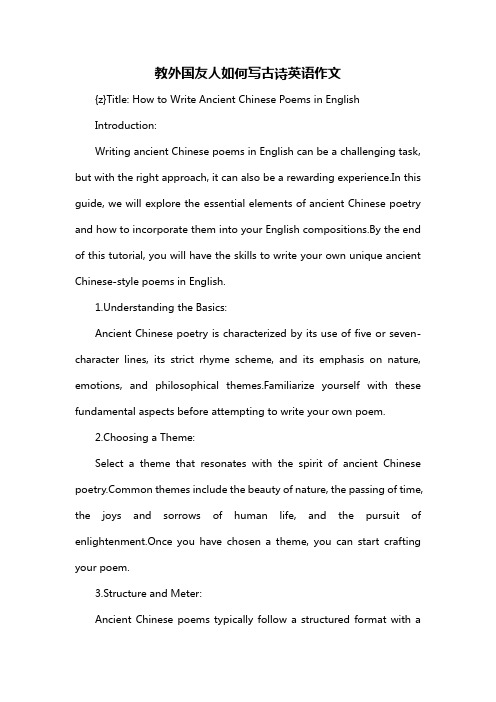
教外国友人如何写古诗英语作文{z}Title: How to Write Ancient Chinese Poems in EnglishIntroduction:Writing ancient Chinese poems in English can be a challenging task, but with the right approach, it can also be a rewarding experience.In this guide, we will explore the essential elements of ancient Chinese poetry and how to incorporate them into your English compositions.By the end of this tutorial, you will have the skills to write your own unique ancient Chinese-style poems in English.1.Understanding the Basics:Ancient Chinese poetry is characterized by its use of five or seven-character lines, its strict rhyme scheme, and its emphasis on nature, emotions, and philosophical themes.Familiarize yourself with these fundamental aspects before attempting to write your own poem.2.Choosing a Theme:Select a theme that resonates with the spirit of ancient Chinese mon themes include the beauty of nature, the passing of time, the joys and sorrows of human life, and the pursuit of enlightenment.Once you have chosen a theme, you can start crafting your poem.3.Structure and Meter:Ancient Chinese poems typically follow a structured format with aspecific meter.The most common forms are the "shi" (poem) and the "ci" (song).The "shi" is characterized by its rigid five or seven-character lines, while the "ci" offers more flexibility with varying line lengths.Pay attention to the meter and try to maintain a consistent rhythm in your poem.ing Traditional Imagery:Ancient Chinese poetry is rich in vivid imagery and metaphors.Draw inspiration from nature, such as mountains, rivers, flowers, and birds, and use them to convey your emotions and thoughts.Additionally, employ metaphors and similes to create depth and layers of meaning in your poem.5.Employing Literary Devices:Incorporate literary devices such as alliteration, assonance, and repetition to enhance the musicality and aesthetic appeal of your poem.These devices can also help create a sense of harmony and balance, which is highly valued in ancient Chinese poetry.6.Refining the Language:Strive for clarity and precision in your language.Each word should carry meaning and contribute to the overall mood and theme of the poem.Keep in mind that ancient Chinese poetry often relies on subtle hints and suggestions rather than direct expression, so try to convey your message indirectly.7.Rhyme and Sound:Ancient Chinese poetry places a strong emphasis on rhyme and sound.Research the various rhyme schemes used in ancient Chinese poetry and apply them to your poem.Pay attention to the tone and intonation of the words, as they can also contribute to the overall rhythm and melody of the poem.8.Revision and Reflection:Once you have completed your poem, take the time to revise and reflect on your work.Read it aloud, seeking areas that may need improvement in terms of rhythm, imagery, and meaning.Consider seeking feedback from others to gain different perspectives and insights.Conclusion:Writing ancient Chinese-style poems in English can be a fascinating and fulfilling endeavor.By understanding the basic principles, incorporating traditional imagery, and paying attention to language and form, you can create poems that capture the essence of ancient Chinese poetry.With practice and persistence, you will be able to produce works that are both true to the ancient Chinese poetic tradition and uniquely your own.。
教外国人古诗词 英语作文
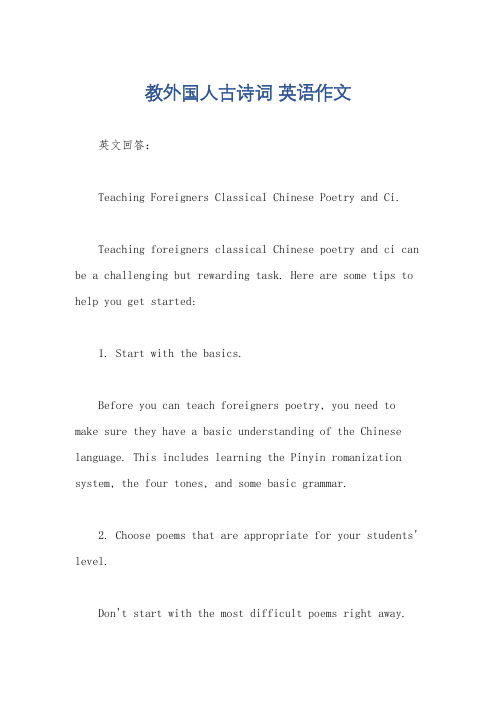
教外国人古诗词英语作文英文回答:Teaching Foreigners Classical Chinese Poetry and Ci.Teaching foreigners classical Chinese poetry and ci can be a challenging but rewarding task. Here are some tips to help you get started:1. Start with the basics.Before you can teach foreigners poetry, you need to make sure they have a basic understanding of the Chinese language. This includes learning the Pinyin romanization system, the four tones, and some basic grammar.2. Choose poems that are appropriate for your students' level.Don't start with the most difficult poems right away.Instead, choose poems that are simple enough for your students to understand, but still challenging enough to keep them engaged.3. Use a variety of teaching methods.Don't just lecture your students about poetry. Instead, use a variety of teaching methods to keep them interested, such as reading aloud, discussing the poems, and having them write their own poems.4. Be patient.Learning classical Chinese poetry takes time. Don't get discouraged if your students don't understand everything right away. Just keep practicing and they will eventually get the hang of it.5. Have fun!Teaching poetry should be enjoyable for both you and your students. So make sure to have fun and let yourstudents enjoy the beauty of classical Chinese poetry.中文回答:如何教外国人古诗词。
向外国人介绍中国古诗的英语作文
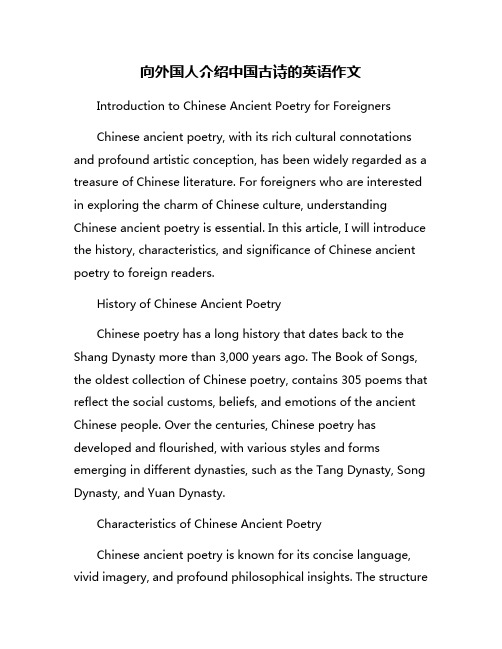
向外国人介绍中国古诗的英语作文Introduction to Chinese Ancient Poetry for ForeignersChinese ancient poetry, with its rich cultural connotations and profound artistic conception, has been widely regarded as a treasure of Chinese literature. For foreigners who are interested in exploring the charm of Chinese culture, understanding Chinese ancient poetry is essential. In this article, I will introduce the history, characteristics, and significance of Chinese ancient poetry to foreign readers.History of Chinese Ancient PoetryChinese poetry has a long history that dates back to the Shang Dynasty more than 3,000 years ago. The Book of Songs, the oldest collection of Chinese poetry, contains 305 poems that reflect the social customs, beliefs, and emotions of the ancient Chinese people. Over the centuries, Chinese poetry has developed and flourished, with various styles and forms emerging in different dynasties, such as the Tang Dynasty, Song Dynasty, and Yuan Dynasty.Characteristics of Chinese Ancient PoetryChinese ancient poetry is known for its concise language, vivid imagery, and profound philosophical insights. The structureof Chinese poetry is based on tonal patterns and rhythmic patterns, with strict rules on the number of characters and syllables in each line. The use of metaphors, allusions, and symbolism is common in Chinese poetry, adding layers of meaning and aesthetic appeal to the poems.Chinese ancient poetry covers a wide range of themes, including love, nature, friendship, and philosophical contemplation. Poets often draw inspiration from their personal experiences, observations of the natural world, and reflections on life and humanity. Through the use of vivid imagery and metaphors, Chinese poets express their emotions and thoughts in a succinct and poetic manner.Significance of Chinese Ancient PoetryChinese ancient poetry holds a special place in Chinese culture and literature, serving as a mirror of the society and values of different historical periods. The study of Chinese ancient poetry not only helps us appreciate the beauty of the language and the artistry of the poems but also provides insights into the history, culture, and values of the Chinese people.For foreigners who are interested in learning more about Chinese culture, exploring Chinese ancient poetry is a valuable and rewarding experience. By delving into the world of Chinesepoetry, foreign readers can gain a deeper understanding of the aesthetics, philosophies, and emotions that have shaped Chinese literature and culture for thousands of years.In conclusion, Chinese ancient poetry is a treasure trove of wisdom, beauty, and cultural heritage that deserves to be explored and appreciated by people from all over the world. By studying Chinese ancient poetry, foreigners can gain insights into the rich and diverse culture of China and deepen their appreciation for the art of poetry. Let us embrace the beauty of Chinese poetry and experience the magic of words that have inspired generations of poets and readers.。
教外国人学唐诗的英语作文
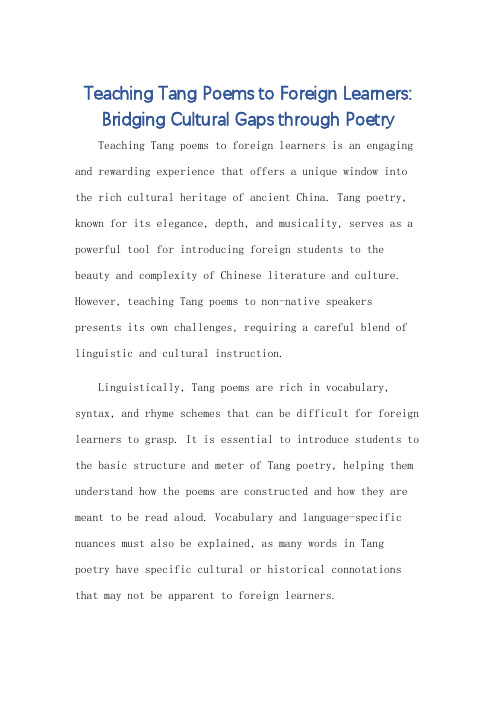
Teaching Tang Poems to Foreign Learners: Bridging Cultural Gaps through PoetryTeaching Tang poems to foreign learners is an engaging and rewarding experience that offers a unique window into the rich cultural heritage of ancient China. Tang poetry, known for its elegance, depth, and musicality, serves as a powerful tool for introducing foreign students to the beauty and complexity of Chinese literature and culture. However, teaching Tang poems to non-native speakers presents its own challenges, requiring a careful blend of linguistic and cultural instruction.Linguistically, Tang poems are rich in vocabulary, syntax, and rhyme schemes that can be difficult for foreign learners to grasp. It is essential to introduce students to the basic structure and meter of Tang poetry, helping them understand how the poems are constructed and how they are meant to be read aloud. Vocabulary and language-specific nuances must also be explained, as many words in Tang poetry have specific cultural or historical connotations that may not be apparent to foreign learners.Cultural understanding is equally important when teaching Tang poetry. Tang poems often allude to historical events, places, and figures that are familiar to Chinese readers but may be unfamiliar to foreigners. It is crucialto provide background information and context, explaining the historical and cultural references in the poems. Thisnot only helps students appreciate the poems more deeplybut also broadens their understanding of Chinese historyand culture.In addition to linguistic and cultural instruction, itis important to foster a sense of appreciation and wonderin students for Tang poetry. Tang poems are not just words on a page; they are expressions of human emotion, philosophy, and observation that have resonated for centuries. By encouraging students to read the poems slowly, imagine the scenes they describe, and reflect on their meanings, teachers can help them discover the beauty and wisdom embedded in these ancient texts.Moreover, interactive and engaging teaching methods are crucial for keeping students engaged and interested. Using activities like group discussions, role-plays, and poetryworkshops can help bring Tang poetry to life and make it more accessible to foreign learners. Encouraging students to write their own poems in the Tang style can also be a rewarding exercise that helps them apply their knowledge and understanding of the form.In conclusion, teaching Tang poems to foreign learners is a challenging but rewarding task that requires a blend of linguistic, cultural, and aesthetic instruction. By providing a comprehensive introduction to the structure, vocabulary, and cultural context of Tang poetry, and fostering a sense of appreciation and engagement, teachers can help foreign learners discover the rich beauty and depth of this ancient Chinese literary genre.**教授外国人学唐诗:以诗歌为桥梁跨越文化鸿沟** 教授外国人学唐诗是一种引人入胜且富有成果的体验,它提供了一个独特的窗口,让外国学生得以一窥中国丰富的文化遗产。
教外国人唐诗英语作文
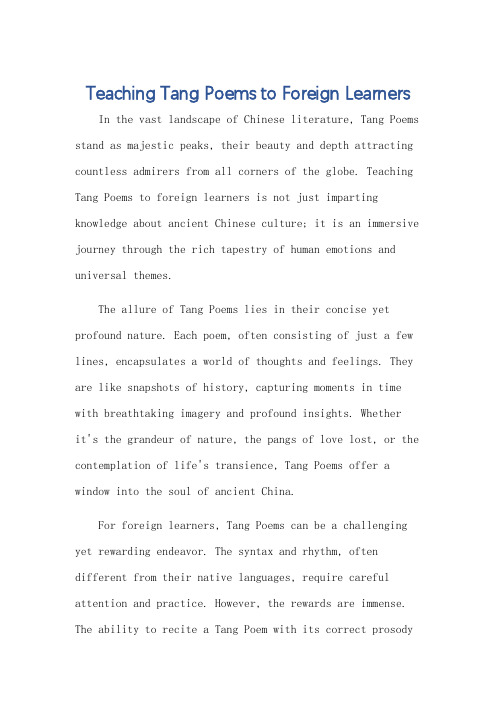
Teaching Tang Poems to Foreign Learners In the vast landscape of Chinese literature, Tang Poems stand as majestic peaks, their beauty and depth attracting countless admirers from all corners of the globe. Teaching Tang Poems to foreign learners is not just imparting knowledge about ancient Chinese culture; it is an immersive journey through the rich tapestry of human emotions and universal themes.The allure of Tang Poems lies in their concise yet profound nature. Each poem, often consisting of just a few lines, encapsulates a world of thoughts and feelings. They are like snapshots of history, capturing moments in time with breathtaking imagery and profound insights. Whetherit's the grandeur of nature, the pangs of love lost, or the contemplation of life's transience, Tang Poems offer a window into the soul of ancient China.For foreign learners, Tang Poems can be a challenging yet rewarding endeavor. The syntax and rhythm, often different from their native languages, require careful attention and practice. However, the rewards are immense. The ability to recite a Tang Poem with its correct prosodyand meaning is not just a testament to linguistic proficiency; it's an acknowledgment of cultural immersion and intellectual growth.Moreover, Tang Poems provide a unique perspective on human experience. Themes such as longing, parting, joy, and sorrow are universal, transcending cultural and linguistic barriers. By studying Tang Poems, foreign learners gain a deeper understanding of not just Chinese culture but also the shared humanity that binds us all.In teaching Tang Poems, it's essential to adopt an inclusive and adaptive approach. Each learner has their unique background and learning style, and it's crucial to cater to these differences. Using interactive methods like group discussions, role-plays, and cultural exchanges can make the learning process more engaging and effective.Moreover, leveraging modern technology can further enhance the learning experience. Multimedia resources like audio recordings, videos, and interactive games can bring Tang Poems to life, making them more accessible and appealing to foreign learners.In conclusion, teaching Tang Poems to foreign learnersis an enriching and transformative experience. It's abridge between ancient China and the modern world, connecting people across cultures and languages. By embracing the beauty and wisdom of Tang Poems, we not only honor our cultural heritage but also contribute to theglobal understanding and harmony.**教授外国人唐诗:文化的桥梁与心灵的触摸**在中国文学的广阔天地中,唐诗宛如巍峨的山峰,以其美丽与深邃吸引着世界各地的无数倾慕者。
如何学会中国古诗词英语作文
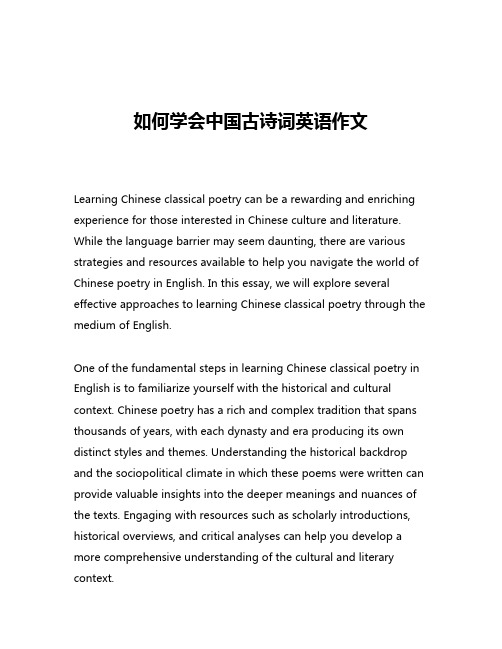
如何学会中国古诗词英语作文Learning Chinese classical poetry can be a rewarding and enriching experience for those interested in Chinese culture and literature. While the language barrier may seem daunting, there are various strategies and resources available to help you navigate the world of Chinese poetry in English. In this essay, we will explore several effective approaches to learning Chinese classical poetry through the medium of English.One of the fundamental steps in learning Chinese classical poetry in English is to familiarize yourself with the historical and cultural context. Chinese poetry has a rich and complex tradition that spans thousands of years, with each dynasty and era producing its own distinct styles and themes. Understanding the historical backdrop and the sociopolitical climate in which these poems were written can provide valuable insights into the deeper meanings and nuances of the texts. Engaging with resources such as scholarly introductions, historical overviews, and critical analyses can help you develop a more comprehensive understanding of the cultural and literary context.Another crucial aspect of learning Chinese classical poetry in English is to immerse yourself in the language and the poetic form. While translations can provide a gateway to the original works, it is essential to delve deeper and explore the unique characteristics of Chinese poetry, such as its emphasis on imagery, symbolism, and the interplay of sounds and rhythms. Studying the structure and conventions of Chinese poetry, such as the use of tonal patterns, parallelism, and the role of allusions, can help you appreciate the artistry and complexity of these works.One effective way to engage with Chinese classical poetry in English is to read and analyze a wide range of translated works. Seek out reputable translations that capture the essence and spirit of the original poems, and compare different versions to gain a more nuanced understanding of the text. Pay attention to the choices made by the translators, such as the use of language, the preservation of cultural references, and the rendering of poetic devices. This comparative analysis can deepen your appreciation for the challenges and subtleties involved in translating Chinese poetry into English.In addition to reading translated works, it can be beneficial to explore the original Chinese texts alongside their English counterparts. While a full mastery of the Chinese language may notbe necessary, a basic understanding of Chinese characters and their meanings can enhance your engagement with the poems. Resources such as bilingual editions, annotated texts, and online tools can help you navigate the Chinese characters and gain a deeper understanding of the linguistic and cultural elements.Furthermore, engaging with the performative aspects of Chinese classical poetry can enrich your learning experience. Many traditional Chinese poems were meant to be recited, chanted, or accompanied by music. Exploring the oral traditions and the rhythmic patterns of these poems can provide a more immersive and embodied understanding of the art form. Attending poetry readings, workshops, or performances can expose you to the aural and performative dimensions of Chinese classical poetry, allowing you to connect with the works in a more visceral and experiential way.Another valuable approach to learning Chinese classical poetry in English is to participate in discussion groups, online forums, or academic courses. Engaging with a community of learners and scholars can provide opportunities to exchange ideas, ask questions, and gain new perspectives on the poems. Participating in close readings, group discussions, and collaborative analysis can deepen your understanding of the texts and help you develop critical thinking skills.Finally, it is important to approach the learning process with patience, curiosity, and a willingness to explore. Chinese classical poetry can be challenging, but the rewards of delving into this rich literary tradition can be immense. By embracing the journey, experimenting with different learning strategies, and remaining open to the nuances and complexities of these works, you can develop a meaningful and lasting appreciation for Chinese classical poetry in English.In conclusion, learning Chinese classical poetry in English requires a multifaceted approach that encompasses historical and cultural context, linguistic exploration, comparative analysis, performative engagement, and collaborative learning. By employing these strategies and resources, you can embark on a rewarding and transformative journey into the world of Chinese poetry, expanding your cultural horizons and deepening your understanding of this enduring literary tradition.。
教外国人古诗词 英语作文
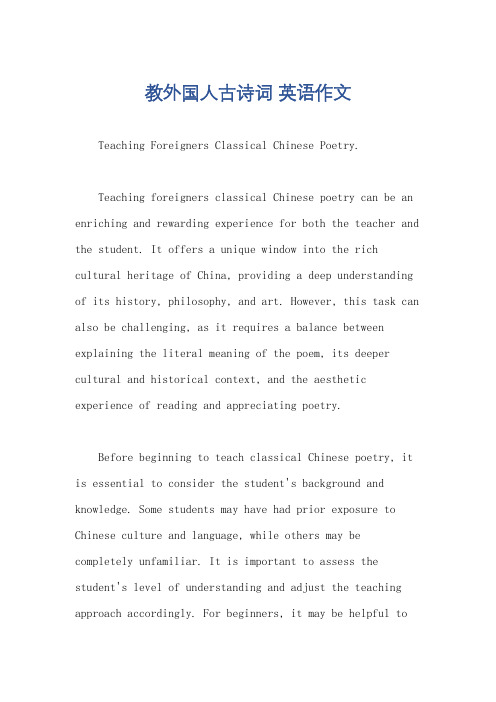
教外国人古诗词英语作文Teaching Foreigners Classical Chinese Poetry.Teaching foreigners classical Chinese poetry can be an enriching and rewarding experience for both the teacher and the student. It offers a unique window into the rich cultural heritage of China, providing a deep understanding of its history, philosophy, and art. However, this task can also be challenging, as it requires a balance between explaining the literal meaning of the poem, its deeper cultural and historical context, and the aesthetic experience of reading and appreciating poetry.Before beginning to teach classical Chinese poetry, it is essential to consider the student's background and knowledge. Some students may have had prior exposure to Chinese culture and language, while others may be completely unfamiliar. It is important to assess the student's level of understanding and adjust the teaching approach accordingly. For beginners, it may be helpful tostart with basic vocabulary and sentence structure, gradually introducing more complex poetic devices and themes.One of the first steps in teaching classical Chinese poetry is to introduce the student to the basic structure and form of the poem. This includes explaining thedifferent types of poems, such as quatrains, sonnets, and odes, as well as the role of rhyme, meter, and stanza. By understanding these elements, students can begin to appreciate the beauty and harmony of the poem as a whole.As students become more familiar with the structure of the poem, they can begin to delve into its deeper meaning. This often requires a combination of literal translation and contextual explanation. Classical Chinese poetry often employs metaphor, simile, and symbolism to convey its messages, and it is important for students to understand these devices and their cultural significance. For example, the use of nature imagery in Chinese poetry often represents deeper emotional or philosophical themes. By explaining these connections, students can begin toappreciate the poem on a deeper level.In addition to explaining the meaning of the poem, it is also important to introduce students to the historical and cultural context of the poem. Classical Chinese poetry spans thousands of years, and each poem is a product of its time and place. By understanding the historical andcultural background of the poem, students can gain a deeper understanding of its message and themes. For example, poems from the Tang Dynasty reflect the prosperity and optimism of that era, while poems from the Song Dynasty may express a sense of melancholy and introspection.Finally, teaching classical Chinese poetry should culminate in an appreciation of the aesthetic experience of reading and appreciating poetry. Poetry is a form of art that evokes emotion and thought, and it is essential for students to be able to appreciate its beauty and power. This can be achieved through reading the poem aloud, discussing its imagery and themes, and comparing it to other works of literature or art. By fostering an appreciation for poetry, students can gain a deeperunderstanding of Chinese culture and its rich heritage.In conclusion, teaching foreigners classical Chinese poetry is a rewarding and enriching experience that offers a unique window into Chinese culture and history. By combining explanation of the poem's structure, meaning, and context with an appreciation of its aesthetic value, students can gain a deep understanding and appreciation of this beautiful form of art.。
外国人读唐诗英语作文

外国人读唐诗英语作文In the vast expanse of literary history, Tang poetry stands as a towering monument, not only in China but alsoin the global literary landscape. Its unique blend of artistry, philosophy, and emotion has captivated readersfor generations, transcending linguistic and cultural barriers. The beauty and depth of Tang poetry are not limited to the Chinese reader; rather, they resonate deeply with foreign readers as well.For foreigners, reading Tang poetry can be a profound cultural experience. The poems, often concise yet profound, offer a window into the rich cultural and historical context of ancient China. The images, metaphors, and themes explored in Tang poetry provide a gateway to understanding the values, beliefs, and aesthetics of the Tang dynasty.One of the most striking aspects of Tang poetry for foreign readers is its remarkable ability to evoke powerful emotional responses. The poignant expressions of love, longing, joy, sorrow, and reflection found in Tang poems resonate deeply with readers of all cultures. The universality of these themes and emotions allows Tangpoetry to speak to people across the globe, transcending the limitations of language and culture.Foreigners also appreciate the artistic craftsmanship of Tang poetry. The precision with which the poets crafted their words, the intricate use of imagery and metaphor, and the harmonious rhythm and rhyme schemes are all hallmarks of Tang poetry. This artistic excellence is admired by readers of all backgrounds, who appreciate the skill and creativity exhibited by the Tang poets.Moreover, Tang poetry offers a unique perspective on the natural world. The poems are often filled with vivid descriptions of landscapes, seascapes, and nature, reflecting the poets' deep connection and respect for the natural world. This emphasis on nature and the cosmos is a refreshing departure from the more anthropocentric perspectives found in much of Western literature. For foreign readers, this alternative perspective offers a valuable opportunity to reconsider their own relationship with the natural world.In addition to its artistic and emotional appeal, Tang poetry also holds significant historical value for foreignreaders. The poems provide a vivid account of the social, political, and cultural transformations that occurredduring the Tang dynasty. By reading Tang poetry, foreigners can gain a deeper understanding of the historical context and background of ancient China, thereby enhancing their understanding of the country's rich cultural heritage.In conclusion, Tang poetry is a bridge between Chinaand the rest of the world, connecting people acrosscultural and linguistic divides. Its beauty, depth, and universality make it a valuable asset in promoting cultural exchange and understanding. As foreigners delve into the world of Tang poetry, they embark on a journey of discovery and understanding that enriches their own cultural horizons and fosters mutual respect and understanding between cultures.**外国人眼中的唐诗世界:跨越时空的诗意对话**在文学的浩瀚长河中,唐诗宛如一座巍峨的丰碑,不仅在中国,而且在全球文学景观中也占有重要地位。
教外国人古诗的作文英语
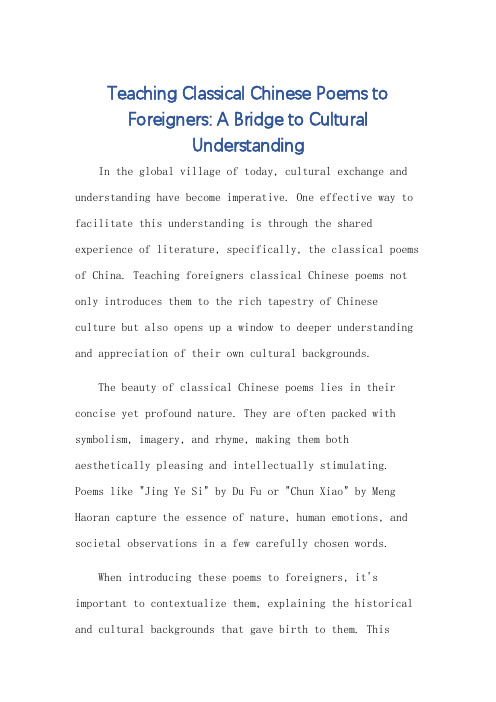
Teaching Classical Chinese Poems to Foreigners: A Bridge to CulturalUnderstandingIn the global village of today, cultural exchange and understanding have become imperative. One effective way to facilitate this understanding is through the shared experience of literature, specifically, the classical poems of China. Teaching foreigners classical Chinese poems not only introduces them to the rich tapestry of Chineseculture but also opens up a window to deeper understanding and appreciation of their own cultural backgrounds.The beauty of classical Chinese poems lies in their concise yet profound nature. They are often packed with symbolism, imagery, and rhyme, making them both aesthetically pleasing and intellectually stimulating. Poems like "Jing Ye Si" by Du Fu or "Chun Xiao" by Meng Haoran capture the essence of nature, human emotions, and societal observations in a few carefully chosen words.When introducing these poems to foreigners, it's important to contextualize them, explaining the historical and cultural backgrounds that gave birth to them. Thiscontextualization helps the learners appreciate the poems' deeper meanings and understand their relevance in thelarger scheme of Chinese history and culture. For instance, explaining the political and social upheavals of the Tang Dynasty can enhance the understanding of Du Fu's poignant observations in "Jing Ye Si".Moreover, the process of translating these poems into foreign languages poses its own challenges and opportunities. While some of the original's nuances may be lost in translation, the exercise itself encourages cross-cultural understanding and respect. It forces thetranslator and the learner to consider the differences and similarities between their own languages and cultures, thus fostering a deeper appreciation for both.Teaching foreigners classical Chinese poems also benefits the learners by helping them develop a more nuanced understanding of their own cultural identities. By comparing and contrasting their own literary traditions with Chinese poems, they can gain insights into the unique qualities of their own cultural heritage. This, in turn,can foster a more tolerant and inclusive approach towards cultural diversity.In conclusion, teaching foreigners classical Chinese poems is not just about imparting knowledge about a foreign culture; it's about fostering mutual understanding, respect, and appreciation between different cultures. It's about building bridges, not walls, and about creating a world where cultural diversity is celebrated and valued.**教授外国人古诗:文化理解的桥梁**在当今这个全球化的大家庭中,文化交流和理解变得至关重要。
教外国人学唐诗的英语作文五十个字
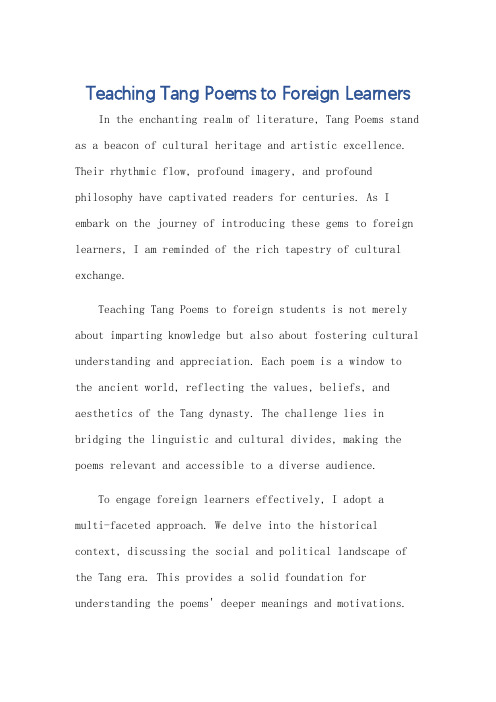
Teaching Tang Poems to Foreign Learners In the enchanting realm of literature, Tang Poems stand as a beacon of cultural heritage and artistic excellence. Their rhythmic flow, profound imagery, and profound philosophy have captivated readers for centuries. As I embark on the journey of introducing these gems to foreign learners, I am reminded of the rich tapestry of cultural exchange.Teaching Tang Poems to foreign students is not merely about imparting knowledge but also about fostering cultural understanding and appreciation. Each poem is a window to the ancient world, reflecting the values, beliefs, and aesthetics of the Tang dynasty. The challenge lies in bridging the linguistic and cultural divides, making the poems relevant and accessible to a diverse audience.To engage foreign learners effectively, I adopt amulti-faceted approach. We delve into the historical context, discussing the social and political landscape of the Tang era. This provides a solid foundation for understanding the poems' deeper meanings and motivations.Language barriers are overcome through interactive exercises, role-plays, and cultural immersion activities.The beauty of Tang Poems lies in their concise yet profound nature. I encourage students to recite the poems aloud, savoring the rhythm and cadence. This not only aidsin memorization but also helps to internalize the poetic language. Visual aids like images and videos further enhance the learning experience, bringing the ancient world to life.As we delve deeper into the world of Tang Poems,foreign learners are treated to a feast of literary masterpieces. Poems like "The Moonlit Night on the Yangtze River" and "The Ballad of Mulan" inspire awe and admiration. The themes of love, loss, nature, and philosophy resonate with learners across cultures, fostering a sense ofuniversal connectivity.In conclusion, teaching Tang Poems to foreign learnersis a rewarding experience that transcends linguistic and cultural boundaries. It not only enhances their language skills but also broadens their cultural horizons. As weembark on this journey together, may the beauty and wisdomof Tang Poems continue to inspire and captivate us all.**教授外国人学唐诗**在文学的迷人领域里,唐诗如同一座文化遗产和艺术卓越的灯塔。
教外国人唐诗英语作文

Teaching Tang Poetry to ForeignersThe art of teaching Tang poetry to foreigners is not only an endeavor that bridges cultural divides but also a journey of mutual discovery and understanding. Tang poetry, renowned for its elegance, profoundness, and rhythmic beauty, stands as a testament to the rich cultural heritage of China. It is, therefore, a privilege to share thisliterary gem with those who hail from different cultural backgrounds.The initial step in teaching Tang poetry to foreignersis to introduce them to the historical context and the unique aesthetic features of this genre. Explaining the social and political milieu of the Tang dynasty, along with the development of poetry as a form of expression, helps foreigners appreciate the depth and complexity of the poems. It is essential to highlight the role of nature, emotion, and philosophy in Tang poetry, which often blend seamlessly to create a harmonious whole.Once the foundation is laid, one can proceed to the actual teaching of the poems. It is advisable to start with shorter and more accessible works, gradually progressing tomore complex and abstract pieces. The use of audio-visual aids, such as translations, illustrations, and even recordings of traditional Chinese music, can greatly enhance the learning experience. These tools not only help foreigners understand the literal meaning of the poems but also evoke the emotional and sensory responses that are integral to appreciating poetry.In the process of teaching, it is crucial to encourage active participation and open discussion. Foreigners often have fresh perspectives and insights that can enrich the understanding of Tang poetry. By allowing them to share their thoughts and feelings about the poems, one creates a dynamic and interactive learning environment that fosters deeper understanding and appreciation.Moreover, it is essential to emphasize the universality of Tang poetry. Despite its Chinese origin, the themes and emotions expressed in these poems are often universal, resonating with people across cultures and eras. By drawing parallels between Tang poetry and similar literary traditions in other cultures, one can further bridge thegap between the foreign learners and this ancient Chineseart form.In conclusion, teaching Tang poetry to foreigners is a rewarding experience that offers insights into both Chinese culture and the universal power of poetry. It requires patience, enthusiasm, and a willingness to explore new perspectives. Through this process, not only do thelearners gain a deeper understanding of Tang poetry, but they also embark on a journey of personal growth andcultural understanding.**教外国人唐诗英语作文**教外国人唐诗不仅是一项跨越文化鸿沟的努力,更是一次相互发现与理解的旅程。
外国人 学习古诗词 英语作文
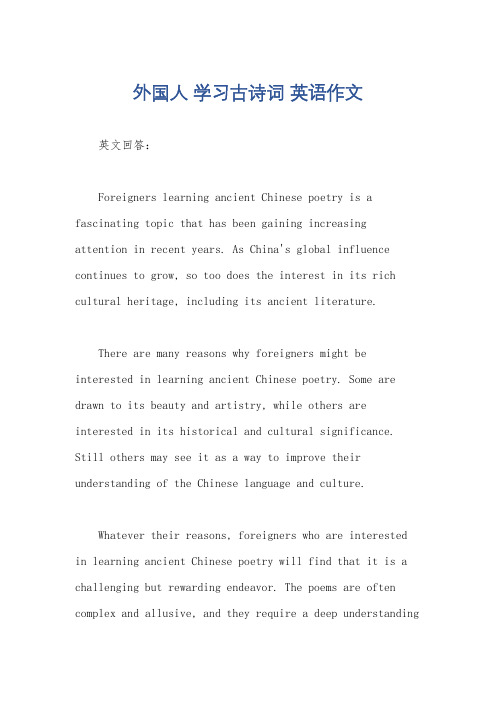
外国人学习古诗词英语作文英文回答:Foreigners learning ancient Chinese poetry is a fascinating topic that has been gaining increasingattention in recent years. As China's global influence continues to grow, so too does the interest in its rich cultural heritage, including its ancient literature.There are many reasons why foreigners might be interested in learning ancient Chinese poetry. Some are drawn to its beauty and artistry, while others are interested in its historical and cultural significance.Still others may see it as a way to improve their understanding of the Chinese language and culture.Whatever their reasons, foreigners who are interested in learning ancient Chinese poetry will find that it is a challenging but rewarding endeavor. The poems are often complex and allusive, and they require a deep understandingof Chinese history, culture, and language. However, with patience and perseverance, it is possible to makesignificant progress in learning to appreciate and understand these beautiful works of art.There are many resources available to help foreigners learn ancient Chinese poetry. There are textbooks, dictionaries, and online courses that can provide a foundation in the language and culture. There are also many translations of Chinese poetry into English, which can help students to understand the meaning of the poems.In addition to formal study, there are many other waysto learn about ancient Chinese poetry. One of the best ways is to simply read the poems and try to understand them.Even if you don't understand every word, you can still appreciate the beauty of the language and the imagery. You can also listen to recordings of the poems being read aloud, which can help you to understand the rhythm and flow of the language.Another great way to learn about ancient Chinese poetryis to attend readings and lectures by experts. These events can provide you with insights into the poems and their historical and cultural context. You can also meet other people who are interested in learning about Chinese poetry, and you can share your experiences and insights.Learning ancient Chinese poetry is a wonderful way to learn about Chinese culture and history. It is also a challenging but rewarding endeavor that can provide you with a deep appreciation for the beauty and complexity of the Chinese language.中文回答:外国人学习古诗词是一个非常有趣的话题,近年来引起了越来越多的关注。
中国古诗谈英语作文
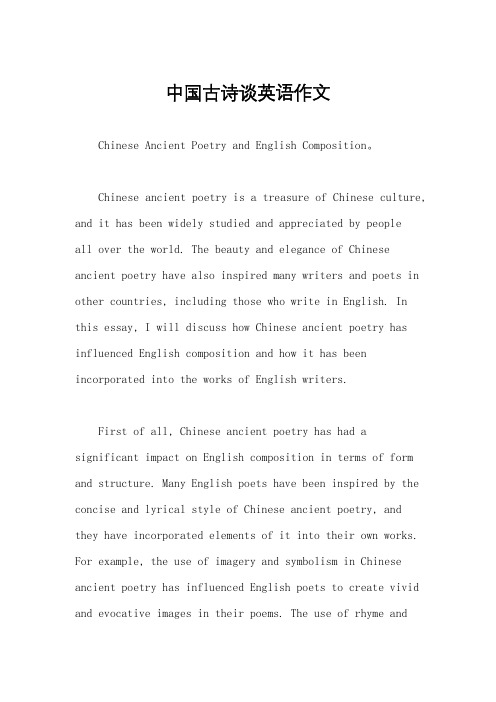
中国古诗谈英语作文Chinese Ancient Poetry and English Composition。
Chinese ancient poetry is a treasure of Chinese culture, and it has been widely studied and appreciated by peopleall over the world. The beauty and elegance of Chinese ancient poetry have also inspired many writers and poets in other countries, including those who write in English. In this essay, I will discuss how Chinese ancient poetry has influenced English composition and how it has been incorporated into the works of English writers.First of all, Chinese ancient poetry has had asignificant impact on English composition in terms of form and structure. Many English poets have been inspired by the concise and lyrical style of Chinese ancient poetry, and they have incorporated elements of it into their own works. For example, the use of imagery and symbolism in Chinese ancient poetry has influenced English poets to create vivid and evocative images in their poems. The use of rhyme andmeter in Chinese ancient poetry has also been adopted by English poets, who have used these techniques to create rhythm and musicality in their own works.In addition to form and structure, Chinese ancient poetry has also influenced the themes and subjects of English composition. Many English writers have drawn on the rich tradition of Chinese ancient poetry to explore universal themes such as love, nature, and the passage of time. For example, the Chinese concept of "yuanfen," or fate, has been explored by English writers who have been inspired by the idea of predestined love and the power of destiny. Similarly, the beauty of nature and the fleeting nature of life, which are common themes in Chinese ancient poetry, have been reflected in the works of English writers who have been influenced by the Chinese poetic tradition.Furthermore, Chinese ancient poetry has been directly translated into English, allowing English readers to appreciate the beauty and wisdom of Chinese poetry. Many English translations of Chinese ancient poetry have been widely acclaimed for their faithfulness to the originaltext and their ability to convey the nuances and subtleties of Chinese poetry. These translations have allowed English readers to gain a deeper understanding of Chinese culture and literature, and they have contributed to the global appreciation of Chinese ancient poetry.In conclusion, Chinese ancient poetry has had a profound influence on English composition, inspiring English writers to adopt the form, structure, themes, and subjects of Chinese poetry in their own works. The beauty and elegance of Chinese ancient poetry have been appreciated and celebrated by English writers, who have incorporated elements of it into their own works. As a result, Chinese ancient poetry has become an integral part of the global literary tradition, enriching the world of English composition with its timeless wisdom and beauty.。
外国朋友写的中文古体诗有几处不妥英语作文
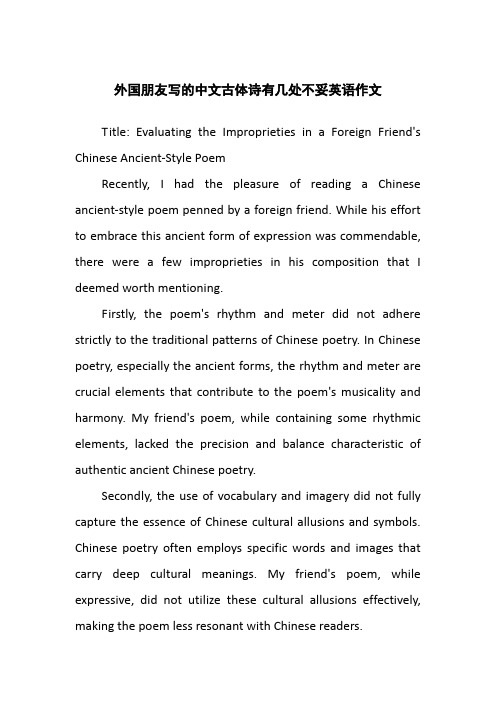
外国朋友写的中文古体诗有几处不妥英语作文Title: Evaluating the Improprieties in a Foreign Friend's Chinese Ancient-Style PoemRecently, I had the pleasure of reading a Chinese ancient-style poem penned by a foreign friend. While his effort to embrace this ancient form of expression was commendable, there were a few improprieties in his composition that I deemed worth mentioning.Firstly, the poem's rhythm and meter did not adhere strictly to the traditional patterns of Chinese poetry. In Chinese poetry, especially the ancient forms, the rhythm and meter are crucial elements that contribute to the poem's musicality and harmony. My friend's poem, while containing some rhythmic elements, lacked the precision and balance characteristic of authentic ancient Chinese poetry.Secondly, the use of vocabulary and imagery did not fully capture the essence of Chinese cultural allusions and symbols. Chinese poetry often employs specific words and images that carry deep cultural meanings. My friend's poem, while expressive, did not utilize these cultural allusions effectively, making the poem less resonant with Chinese readers.Lastly, the poem's thematic content did not align with the traditional themes explored in ancient Chinese poetry. Ancient Chinese poetry often deals with nature, emotions, and philosophical reflections. My friend's poem, while original in its ideas, did not quite fit into the traditional thematic framework, making it stand out in a way that might not have been intended.In conclusion, while my foreign friend's attempt to compose a Chinese ancient-style poem was admirable, there were certain improprieties in his work that needed to be addressed. These included issues with rhythm and meter, vocabulary and imagery, and thematic content. With further study and practice, I believe he can improve his skills in this fascinating and challenging genre of poetry.。
- 1、下载文档前请自行甄别文档内容的完整性,平台不提供额外的编辑、内容补充、找答案等附加服务。
- 2、"仅部分预览"的文档,不可在线预览部分如存在完整性等问题,可反馈申请退款(可完整预览的文档不适用该条件!)。
- 3、如文档侵犯您的权益,请联系客服反馈,我们会尽快为您处理(人工客服工作时间:9:00-18:30)。
Cognitive Research on Teaching Strategies of Chinese Ancient Poems forForeignersGuoli LiuSchool of foreign studies Henan Polytechnic University,China 454003liugl@AbstractüImages in Chinese Ancient Poems are usually the punch lines and the key points in Chinese for foreigners. According to the Image Schema Theory and the Mental Space Theory of Cognitive Linguistics, teachers should manage to build up schemas of Chinese culture in the minds of foreign students by introducing them the backgrounds and stories contained in Ancient Poems. So that foreigner students can get the meaning between lines and go further to enjoy Chinese Ancient Poems. Meanwhile, it is helpful to introduce Chinese culture to the world.Key Wordsü Ancient Poem Image Schema Chinese forForeignerI. IntroductionChinese Ancient Poems are a very important part inteaching Chinese for foreign students. Meanwhile, because ofthe rich images in Ancient Poems and the differentbackground, ways of thinking and culture, it is difficult forforeign students to understand and appreciate Chinese Ancient Poems, for many images of Chinese culture are absent in theirminds. In order to enable foreign students to appreciate thesepoems, teachers have to construct the image schemas in theirminds.II. Images in Chinese Ancient PoemsImages contain the values, ways of thinking, life-style,belief and customs of a nation. “Milky Way” and “Yinhe”, forinstance, are two images of different nations. They have different cultural meaning though they have the sameinstruction. The former reminds people of the ancient Greekmyth while the latter, a beautiful Chinese legend of “theCowboy and the Weaving Girl”.There are a large variety of images, for example, a plant,a bird or beast, an idiom, a proverb, an allusion, a metaphor, even a number, etc. Different nations have their uniqueimages because of their different backgrounds and customs. There are more fascinating images in Chinese Ancient Poems.It may be a hero in history (Qu Yuan in the sentence of “Yuan and Xiang River dry never, Qu Yuan grudges forever.”, a traditional festival (Qing Ming Festival in “On Qing Ming shower after shower it rains, lost a traveler’s soul seems.”ˈ a name of a place( Yang Zhou in “Sailing to Yang Zhou in the March of prosperous blossom.”, title of a poem (Girls of Shang feel nothing about the loss of their country, still singing Hou Ting Hua on the other side of the river.”, an allusion (the cowboy and the weaving girl in “the night in the imperial palace feels cool as water, nothing they can do in bed but looking at the stars of Cowboy and Weaving Girl.”, and so on.III. Theories of “Image Schema” and “Metal Space”A. the Image Schema theorycThe term of Image Schema theory was firstly put forward by Mark Johnson in 1987 based on the philosophy of embodiment and its main characteristics were expounded in the book titled The Body in the Mind: The Bodily Basis of Meaning, Imagination and Reason. Image schema is a dynamic pattern appearing repeatedly in the process of inter-acting and moving perception, it can provide coherence and structure for people’s experience. People gain the image schemas in the process of inter-active experience between human being and outside world. Schema refers to a cognitive structure that can process the information and experience into a certain commen sense (Wang Yin, 2005, 65-67. Image schema is a mode that stores a person’s former knowledge and experience in his mind. It does not simply pile the facts and experience but categorize them into ordered knowledge systems. Schema is the basis to know the world, it will reorganize, re-understand and re-remember the new information. It links the new information with the former knowledge in a person’s mind. Decoding and recoding the newly-input information rely on the schemas the structures or net. These newly-input information must match the schemas in mind, a person can understand the information. Therefore, the knowledge stored in readers’ minds functions greatly to understand new information. As is known, different community members get different knowledge and value affected by their different traditions, cultures, backgrounds, religions and beliefs. This cultural cognitive mental state wasstored in mind in the pattern of schemas and it forms the cultural cognitive schema.B. Metal Space TheoryG. Fauconnier put forward Metal Space Theory in his book Metal Space(1985/1994. He raised Conceptual Integration Theory(1997 and Conceptual Blending Theory(2002 in recent years. According this theory, the metal space is divided into four parts of input space I, input space II, blending space and generic space. The four spaces are linked with mapping to form a conceptual blending net. The process of mapping from input space to blending space is called “compression”, that is, it is a process to simplify the complex concepts from different input spaces to a new, complete and united space. The blending concepts are stable and easy to remember. Of its function, mental space is way we unconsciously organize our background cognitive process when we speak and think. By mapping and inserting the partial structure and background, new structure, action, concept, feeling and understanding will be formed in the blending space.IV. Strategies of image teaching in ancient poemsWestern poems stress on logical reasoning and are very rigorous; while the Chinese poems stress on image combination, very vagarious and indirect. It is just the vague and indirect words that fly the reader’s imagination, so that reader s can feel thebou ndlessness and magnificence of the sentences “straightly rising the military smoke in the sands, more round seems the sinking sun over the broad river.” Chinese readers have the same background and culture so that they can get the similar feeling. The images of “the sands”, “military smoke”, “broad river” and “sinking sun” can trigger them the similar imagination. While the foreign students cannot gain the same feeling because of the different background, they cannot appreciate the beauty of Chinese ancient poems.A. Construction of Image SchemaThere will be two input spaces in foreign students’ minds according to the Metal Space Theory: one is the cognitive domain of Chinese culture and the other is the domain of native culture. The two spaces will interact and connect and finally form a new blending space. While reading Chinese poems, foreign students will understand them with their native culture and way of thinking unconsciously and of cause, they will get different understanding. The reason is the absence of Chinese images in their minds. So we have to try to contrast the Chinese images in the foreign students’ minds, because, according to G. Fauconneir, these images schemas will be stored for a long time in their minds. When they get to know the story o f “the cowboy and the weaving girl”, for example, they will not equal “the Silver River” in Chinese culture with “ the Milk Way” in the western culture.B. Strategies to construct image schemaIn teaching Chinese for foreigners, teachers usually explain the meanings of the poems to students only, instead of analyzing the culturing meaning of the images for the reason that teachers may also be lack of the knowledge of ancient poems. So the foreign students cannot enjoy the beauty of the poems though they get the meaning. Vagueness is one character of Chinese ancient poems, it enables readers to imagine freely. Otherwise, Chinese ancient poems contain rich meanings with less words. That is because in Chinese ancient poems there are a great number of images, Chinese readers can produce rich imagination while reading them, they can get the true meaning that the images contain and further more, they can enjoy the poems. But this is not true for foreign students for they don’t have these image schemas in their minds, they don’t know the cultural background and the meaning they contain. If teachers fail to explain the images to foreign students, it will cause the loss of culture and they cannot get the true meaning of the poems. So, in the process of teaching, teachers must show both the cultural background and true meaning of the images to foreign students. So that the foreign students canconstruct the image schemas of Chinese culture in their minds and they will not misunderstand them when in read them in other poems.Li Bai’s Qing Ping Tune (the Second, for example:A red red peony passes its fragrance to the pearls of dew,Even the Clouds and Rain of Mount Wu are not as fair as you.Who is, in the palace of Han, alike?Feiyan has to turn to her dress new.This is the second one of the three poems in the title of Qing Ping Tune written by Li Bai to eulogize Yang Guifei. Li Bai combines the peony and Yang Guifei together, peony is Yang Guifei and Yang Guifei is as pretty as peony. The first line describes the bright color and tempting aroma of the peony, even the dews on it are fragrant. So beautiful is the peony and so pretty is Yang Guifei. They are more fairy than the Goddess of Mount. Wu who is flowing cloud in the morning and light rain in the evening. Even Zhao Feiyan, the beauty of Han Dynasty, has to turn to new dresses.In this poem, the poet quotes the allusions of “Clouds and Rain of Mount. Wu” and “Zhao Feiyan”. But the foreign students have no the image schemas of the two stories. They know nothing about the Goddess of Mount. Wu and Zhao Feiyan if teachers do not tell them the stories and they would not grasp the beauty of the poem. So teachers must tell the stories to foreign students.According to the record of Gao Tang Fu written by Song Yu, once Chu Xiangwang (the King of Chu Kingdom traveled to a Cloud–and-Dream Platform together with Song Yu. Seen from far away, the platform was surrounded by changeable clouds. Chu Huaiwang asked Song Yu: “what’s the air?” Song Yu answered: “it is the so-called Clouds. Once a time, our former king travelled to Gao Tang, he was tired and had a snapat the noon. In dream a woman told him: ‘I am the Goddess of Mount. Wu, a guest of Gao Tang. News came that you were here in Gao Tang. I’m willing to make bed for you.’ Our fo rmer king made love with her. The woman said while leaving: ‘I live on the southern slope of Mount. Wu and to be flowing clouds in the morning and light rain in the evening. I’m under the platform from morning till evening.’”Zhao Feiyan was the queen of Liu Ao, King of Han Dynasty. Her given name was Yizhu. She was as light as a swallow and danced very well, so people call her Zhao Feiyan. It is said that the King specially made a crystal plate for her. Putting the plate on one palm of a person, Zhao Feiyan can dance on it gracefully.After learning the two stories, foreign students not only understand the poem more deeply but also build the image schemas of “Zhao F eiyan” and “the Clouds and Rain of Mount. Wu” in their minds and these images will be kept f or a long time even during their lives. They will not be frustrated by the allusions when they meet them in the future reading.V. ConclusionThe images in Chinese Ancient Poems playan important role in containing the poets’ feeling.Foreign students are faced with great difficulties to understand and enjoy them because of the absence of the Chinese images in their minds. If Chinese teachers can explain the images to them to construct the schemas of these Chinese images, foreign students will be easy to understand the poems so that they can enjoy Chinese Ancient Poems. It is helpful for the introduction of Chinese culture to the word.References[1]F.Ungerer & H.J.Schmid. An Introduction to CognitiveLinguistics. Shang Hai: Foreign Language Teaching and Res earching Pressˈ2008.[2]YinWang. Research on Cognitive Linguistics[M]. ChongQing: Chong Qing Press, 2005. (in Chinese[3]Dingfang Shu. An Introduction to Cognitive Semantics[M].Shang Hai: Shang Hai Foreign Language Education Press, 2008. (in Chinese[4]Zhengyang Gu. Cultural Research on Chinese-Englishtranslation of Chinese Ancient Poems[m]. Shang Hai: Shang Hai University Press, 2007. (in Chinese[5]Ping Liu & Wenhua Zeng . Difference of CognitiveCultural Schema and Translation Strategies[J]. Journal of Wu Ha n Polytechnic University, 2003.4.。
